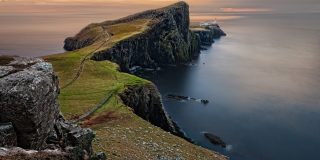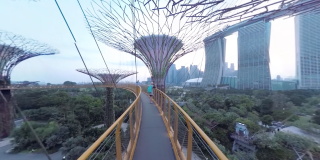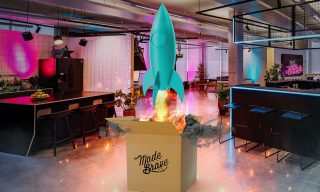COVID-19 really is having a drastic impact on communities across the globe. The virus is forcing those that can to work from home, while those who can’t find themselves either in harm’s way or without a job at all. With so many finding themselves in self-isolation, many questions have emerged:
‘What about our mental health?’
‘How can we stay connected?
‘How do we stay healthy?’
‘How can we travel?’
The world is a wondrous place. A veritable feast of sights, smells, sounds, people, animals, and things. So, how do we continue to enjoy and experience the world during this period of self-isolation? Are we to sit inside and watch the world pass us by from the window?
I love exploring the Scottish countryside, so this is a difficult task for me, especially now that it’s officially springtime and the land is starting to wake from its deep winter slumber. As a creative technologist, my work involves using technology to create meaningful experiences. Technology has the power to change all manner of everyday life for the better, elevating our individual and collective experiences.
Tourism and creative tech
When it comes to our imagination, there is no boundary between ideas, time, and space. Each is ambiguous, influencing and interacting with each other. Given the right visual and auditory clues with an engaging narrative, we have the ability to transport ourselves through time, space, and physical matter itself.
Considering tourism, virtual reality is a medium that has the power to expand our understanding of the physical world and take us to places we never dreamed of. It’s the transformative power of VR, coupled with our imagination’s ability to take us beyond the limits of natural law, that can help the tourism industry during this difficult time—long after COVID-19 has come and gone.
With this vast scope of creative freedom, we should characterise VR tourism into two categories:
1. Those which simulate standard forms of tourism
2. Those which are impossible in the real world
Virtual reality and the whisky industry
Whisky exists because of a cherished heritage that holds process and tradition close to its heart. It’s interwoven into the land, the people, the music we play and the stories we tell. It is a visceral, textured story, and a perfect canvas to explore the potential benefits technology can bring during this difficult time.
Here at MadeBrave, we’ve worked with several renowned whisky brands, and we understand how important ‘experience’ is to this industry. Whether it’s the simple process of pouring a dram for you and a friend to share over a story or traveling to your favourite distillery to see and learn about how your beloved liquid is made. With distillery tours being cancelled along with the rest of the tourism industry, a significant amount of income is under threat for whisky brands.
The World Travel & Tourism Council has estimated the virus is likely to cause a three-month disturbance to the tourism industry, causing a 25% annual reduction in income for an estimated 50 million workers worldwide. Therefore we should look to alternative forms of tourism to keep a steady stream of engagement, revenue, and conversation revolving around the whisky industry to make sure it isn’t forgotten about.
In the short term, VR might be an all-out replacement for traditional tourism. VR could be an important tool for the whisky industry, allowing people to visit any distillery virtually while also acting as a conversation starter between potential tourists and brands. Though a few whisky brands such as Glenfiddich and The Macallan have created their own whisky experiences, it’s time the wider whisky industry adopted this technology to the same degree as other tourism sectors.
Learning from other tourism sectors
One successful application of standard virtual tourism was a collaboration between Thomas Cook and Samsung, offering a realistic presentation of Thomas Cook locations around the world. Featured in Bloomberg, PSFK, and Marketing Week, the project created a 190% uplift in New York excursions bookings.
A step beyond standard virtual tourism experiences is ‘impossible VR tourism’. One example of this is from French startup FlyView which has a VR attraction enabling tourists to see and feel what it would be like to fly over Paris with a jetpack.
Another example of impossible VR tourism comes from the Four Seasons Resort Oahu at Ko Olina who introduced a ‘virtual reality wellness experience’ in which participants take a relaxing voyage through deep space and deep oceans. Similar activations could focus on the beautiful Scottish landscape, transporting people from their homes into situations which would be impossible otherwise.
Some closing thoughts
It’s safe to say VR tourism cannot and will not replace traditional forms of tourism. However, in these times of mass isolation, it is important to explore new and creative alternatives to allow people to keep seeing and experiencing Scotland and the rest of the world in all its beauty.
Once traditional tourism has regained its footing, VR tourism could transition into a supporting role, allowing brands to tell stories about things that are difficult to experience. We could transport ourselves to places in space and time, make ourselves super small or super big—anything that helps support the narrative of the physical experience.
In closing, yes, COVID-19 brings with it a lot of uncertainty, but it is in these times that we can expect to see real innovation and progress. Let us try and make the best of this situation and use this as a catalyst to assess how the tourism industry could adapt to changing technology. Let us consider how we can provide a more sustainable, accessible, and environmentally conscientious option which enables people to see the world, even from their living room sofa.
Originally posted by Calum Crotch on LinkedIn.
Need some help developing your brand strategy around COVID-19? Get in touch.






